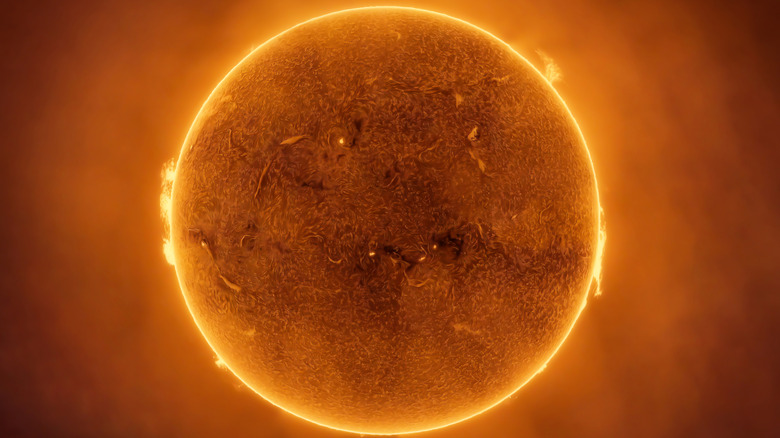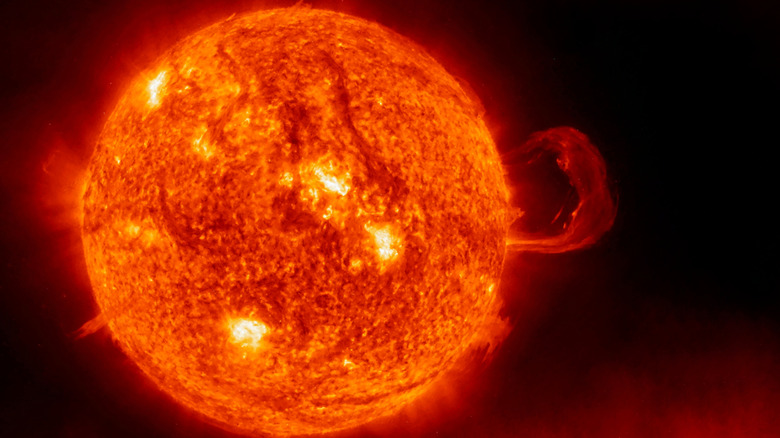How Scientists Predicted The Exact Year All Life On Earth Will End
The Earth has seen five massive extinction events so far, not to mention multiple large-scale megafaunal extinctions such as the one which occurred in the late-Pleistocene epoch and wiped out hordes of mammal species, including the woolly mammoth. Thus far, however, human beings have managed to avoid being completely eradicated like so many species in the history of life on Earth. That's not to say we're going to last forever, though.
It might be a slightly macabre point to make, but eventually, something's going to get us. If we manage to survive the multiple threats currently facing our world and maintain a presence on Earth until the very end, that end will be an awesome and terrifying thing to witness. Why? Because the Sun is going to swell up and become what's known as a red giant, devouring all the planets in its wake, including our own.
The death of our sun will be a slow process that ultimately wipes out life and any possibility of life on every planet in our solar system. But such an event is a long, long way off. Scientists believe the Sun is halfway through a 10-billion-year lifespan, which means we've got roughly another 5 billion years before our star becomes a red giant. Sadly, the sun will manage to make life on our planet impossible long before it becomes a red giant, and supercomputers have now predicted that such a thing will happen a lot sooner than 5 billion years from now.
Scientists predict the year our planet will become inhospitable
Predicting the death of our entire species doesn't seem like the most fun you can possibly have with science, but that's exactly what a team of NASA scientists and researchers from the University of Toho in Japan have done. The group developed complex calculations based on mathematical modeling powered by supercomputers to determine when life will be completely unable to survive on Earth and published their findings in Nature. According to the researchers, life on our planet will be impossible by the year 1,000,002,021.
To calculate this grim prediction, the team used what they termed a combined biogeochemistry and climate model to produce a likely timescale of atmospheric conditions on Earth. The results showed that solar fluxes are likely to reduce oxygen in our atmosphere over time, with the Sun continuing to expand, reducing air quality, raising temperatures, and rendering the planet inhospitable within a billion years.
Based on the prediction that all life will perish in the year 1,000,002,021, we've got around 999,999,996 years to go. Almost a billion years is a long way off, but it's a heck of a lot shorter than 5 billion years, and is a reminder that life is by no means an indefinite feature of our planet. When you consider the late great Stephen Hawking's grim prediction that our species needs to colonize another planet within 100 years, things start to feel even bleaker.
The Sun is already hinting at a bleak future
In May 2024, Earth was struck by the first severe "G5" level geomagnetic storm in more than two decades as a result of eruptions on the surface of the sun which sent charged particles speeding outwards into our solar system and towards Earth. During the event, Earth's upper atmospheric layer, the thermosphere, was heated to abnormally high temperatures, while on the ground transformers overheated and GPS-guided tractors failed to operate correctly. The storm also created auroras around the world.
With that in mind, it might seem as though the sun is already becoming volatile, but to be clear, these geomagnetic storms have become more frequent due to the sun reaching solar maximum, which occurs every 11 years. The most powerful solar storm yet recorded actually happened back in 1859 with the Carrington Event, during which large solar flares sent billions of particles hurtling towards Earth. Were a similar event to happen today, our communication networks and electrical grids would be crippled.
It might be some time before life on Earth becomes impossible, and planetary colonization efforts might well have proven successful by the time we have to worry about the sun making our planet inhospitable. But with every solar maximum phase comes a reminder of our central star's volatility and ultimately its ability to wipe out the very life it makes possible on our planet.


